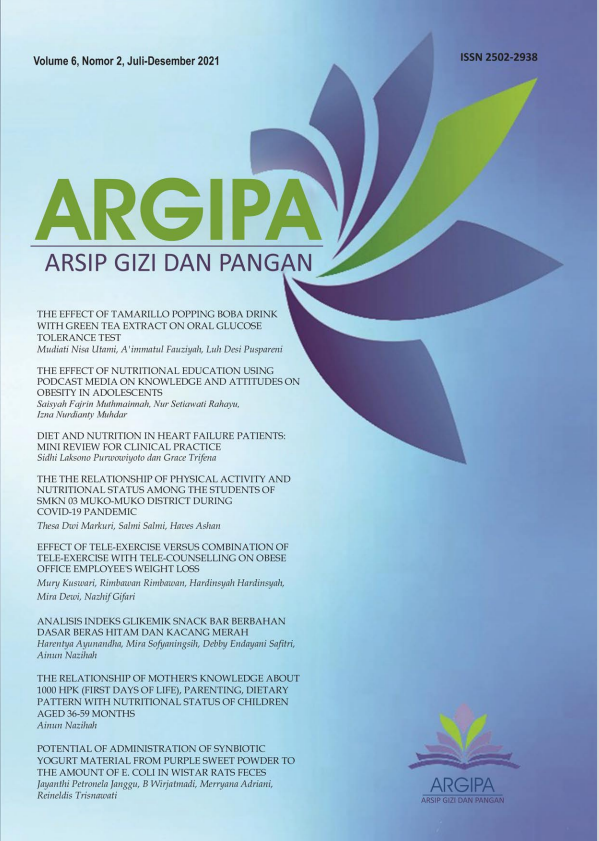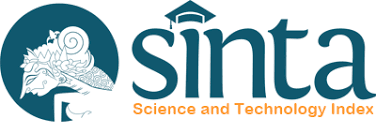The The relationship of physical activity and nutritional status among the students of SMKN 03 Muko-Muko District during covid-19 pandemic
DOI:
https://doi.org/10.22236/argipa.v6i2.6786Keywords:
Adolescent, Covid-19 Pandemic, Nutritional Status, Physical Activity.Abstract
Overweight and obesity prevalence in Indonesian adolescents tend to increase in the last few decades. The decrease in physical activity is one of the risk factors for this case. Covid-19 pandemic has caused a physical activity decrease in adolescents. This study aimed to determine the relationship between physical activity and nutritional status among the SMKN 03 Muko-Muko students during covid-19 pandemic. This was analytic observational with a cross-sectional study. The study was followed by 76 of 12th grade SMKN 03 Muko-Muko district students that qualified for inclusion and exclusion criteria by purposive sampling. The physical activity level of the subject was determined by Global Physical Activity Questionnaire (GPAQ) and the nutritional status was determined using body mass index (BMI) and categorized based on the Asian-Pacific category. As the result, 69,7% of the subjects had a moderate level of physical activity and 30,3% in high level, respectively. As much as 48,6% of the subjects had normal BMI, 36,8% were underweight and 14,5% were overweight and obese. Statistical analysis by Chi-square concluded that there was a relationship between physical activity and nutritional status among the SMKN-03 Muko-Muko District students during covid-19 pandemic.Downloads
References
Fonseca, D. C., Sala, P., Ferreira, B. A. M., Reis, J., Torrinhas, RS., Bendavid, I., et al. (2018). Body weight control and energy expenditure. Clinical Nutrition Experimental, 20, 55–59.
Gregory, J. W. (2019). Prevention of obesity and metabolic syndrome in children. Frontiers in Endocrinology, 10, 669.
Guthold, R., Stevens, GA., Riley, L. M., & Bull, FC. (2020). Global trends in insufficient physical activity among adolescents: a pooled analysis of 298 population-based surveys with 1·6 million participants. The Lancet Child and Adolescent Health, 4(1), 23–35.
Hall, G., Laddu, D., Phillips, S. A., Lavie, C. J., & Arena, R. (2021). A tale of two pandemics : How will COVID-19 and global trends in physical inactivity and sedentary behavior affect one another? Progress in Cardiovascular Diseases, 64, 108–110.
Hasnizar, H., Aritonang, E., & Sudaryati, E. (2020). Relationship of physical activities with nutrition status in students at SMK Negeri 1 Percut Sei Tuan Deli Serdang District. Britain International of Exact Sciences (BIoEx) Journal, 2(1), 377–383.
Izhar, M. D. (2020). Hubungan antara konsumsi junk food, aktivitas fisik dengan status gizi siswa SMN Negeri 1 Jambi. Jurnal Formil (Forum Ilmiah) Kesmas Respati, 5(1), 1–7.
Kemenkes RI. (2013). Riset Kesehatan Dasar 2013. In Badan Penelitian dan Pengembangan Kesehatan.
Kemenkes RI. (2019). Laporan Nasional Riskesdas 2018. In Badan Penelitian dan Pengembangan Kesehatan.
Krismawati, L. D. E., Andayani, N. L. N., & Wahyuni, N. (2019). Hubungan antara aktivitas fisik dengan indeks massa tubuh (IMT) pada remaja usia 16-18 tahun di SMA Negeri 2 Denpasar. Majalah Ilmiah Fisioterapi Indonesia, 7(1), 29–32.
Myers, J., Kokkinos, P., & Nyelin, E. (2019). Metabolic syndrome. Physical Activity, Cardiorespiratory Fitness, and the Metabolic Syndrome, 11(1), 1652.
Ng, K., Cooper, J., McHale, F., Clifford, J., & Woods, C. (2020). Barriers and facilitators to change in adolescent physical activity during COVID-19. BMJ Open Sport and Exercise Medicine, 0, e000919.
Popkin, B. M. (2015). Nutrition transition and the global diabetes epidemic. Current Diabetes Reports, 15(9), 64.
Romieu, I., Dossus, L., Barquera, S., Blottière, HM., Franks, PW., Gunter, M., et al. (2017). Energy balance and obesity: what are the main drivers? Cancer Causes and Control, 28, 247–258.
Rukmana, E., Permatasari, T., & Emilia, E. (2020). Hubungan antara aktivitas fisik dengan status gizi pada remaja selama pandemi covid-19 di kota Medan. Jurnal Dunia Gizi, 3(2), 88–93.
Schoeller, D. A. & Thomas, D. (2015). Energy balance and body composition. World Review of Nutrition and Dietetics, 111, 13–18.
Simbolon, D., Yorita, E., & Talib, R. A. T. (2019). The risk of hypertension in adulthood as a consequence of adolescent obesity. Kesmas: National Public Health Journal, 14(1), 28–36.
Sommer, A. & Twig, G. (2018). The impact of childhood and adolescent obesity on cardiovascular risk in Adulthood: a systematic review. Current Diabetes Reports, 18, 91.
Sutrio. (2017). Hubungan asupan energi, pengetahuan gizi, dan aktivitas fisik terhadap status gizi siswa Sekolah Menengah Atas Global Madani Kota Bandar Lampung tahun 2016. Jurnal Kesehatan Holistik, 11(1), 23–33.
Thivel, D., Tremblay, A., Genin, P. M., Panahi, S., Rivière, D., & Duclos, M. (2018). Physical activity, inactivity, and sedentary behaviors: definitions and implications in occupational health. Frontiers in Public Health, 6, 288.
Tulchin-Francis, K., Stevens, W., Gu, X., Zhang, T., Roberts, H., Keller, J., et al. (2021). The impact of the coronavirus disease 2019 pandemic on physical activity in US children. Journal of Sport and Health Science, 00, 1–10.
WHO. (2012). Global Physical Activity Questionnaire (GPAQ) Analysis Guide. Geneva: World Health Organization, 1–22.
WHO. (2000). The Asia – Pacific Perspective: Redefining Obesity and Its Treatment. Australia: Health Communication Australia Pty.
WHO. (2018). Global Action Plan on Physical Activity 2018-2030: More Active People For a Healthier World. Geneva: blossomin.it.
Wu, XY., Han, LH., Zhuang, LH., Luo, S., Hu, JW., & Sun, K. (2017). The influence of diet quality and dietary behavior on health-related quality of life in the general population of children and adolescents: a systematic review and meta-analysis. PLoS ONE, 12(11), e0187668.
Zenic, N., Taiar, R., Gilic, B., Blazevic, M., Maric, D., Pojskic, H., et al. (2020). Levels and changes of physical activity in adolescents during the COVID-19 pandemic: contextualizing urban vs. rural living environment. Applied Sciences, 10, 3997.

















